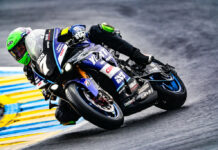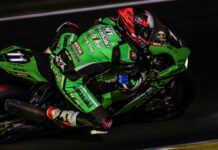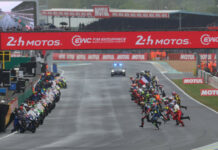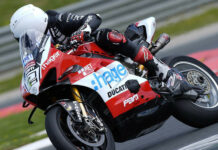ICHIRO YODA: KAWASAKI RACING DIRECTOR When Ichiro Yoda joined Kawasaki’s MotoGP project for the 2005 season, he brought with him more than 20 years of grand prix engineering experience. For two years the Japanese engineer has been the driving force behind the development of Kawasaki’s 990cc Ninja ZX-RR, a period that culminated in the podium finishes by Olivier Jacque and Shinya Nakano in Shanghai and Assen respectively. For the 2007 season Yoda takes on a new role with the reorganised Kawasaki Racing Team. Having been responsible for managing the development of the 800cc Ninja ZX-RR that Randy de Puniet and Olivier Jacque will campaign for the first time this season, a promotion to the position of Race Director means that, this year, Yoda is responsible for overseeing all aspects of Kawasaki’s MotoGP racing activities. Q: There have been some big changes for the Kawasaki Racing Team since Kawasaki made the decision to bring the team ‘in-house’ for the 2007 season. As part of this reorganisation you’ve been promoted to the position of Race Director, but how has that changed your role for the coming season? A: Now Kawasaki has brought their MotoGP team in-house, my role has changed significantly. Our Technical Manager, Naoya Kaneko, will now take responsibility for technical issues, while I take on more of the commercial aspects of running a MotoGP team, such as budget control. I will also be working closely with our Competition Manager, Michael Bartholemy, in other areas, such as human resources and logistics. It’s a big change for me, but I’m looking forward to my new role with the team. My biggest task this season will be to put in place the new way of operating as an in-house, factory team, as this will be different to last year. This year our only focus is on results and development. Q: Will you be based in Japan this coming season, or will you move to Europe to be closer to the team base in the Netherlands? A: I will be based at the headquarters of Kawasaki Motors Europe in Amsterdam, which is about two hours drive from the team’s offices in Heerlen. Q: Will your new role still allow you to play an active part in the development of the Ninja ZX-RR? A: Development will continue in Japan, but that doesn’t mean that we won’t use outside suppliers in Europe for certain components. Because I’ll be based in Europe I will be much better placed to ensure that we choose the best supplier for the job, and that the components meet our requirements, both in terms of quality and delivery time. So yes, I will still have some involvement in the development process. Q: Whatever your role now, you led the development of Kawasaki’s new 800cc machine last season. At the start of the development process you must have had a list of design aims, but what was at the top of that list? A: We knew from the start that we would have to rev the 800cc engine harder and higher if we were to liberate enough power to be competitive. We calculated that we would need to rev the first evolution of the new engine to 18,000 rpm to achieve our power target and at this level a conventional valve train, with a spring return, is inefficient. So, our first major decision was to run a pneumatic valve system on the new engine. This allowed us not only to achieve our initial target, but also gives us more options for the future. Q: Was the pneumatic valve system developed in-house by Kawasaki, or was the technology bought in from an outside supplier? A: This technology is not widely used in the motorcycle industry, so we had to bring this technology in from an outside supplier. But, as a lot of people have discovered to their cost in the past, the technology doesn’t transfer directly. A lot of modifications are required to take what is effectively car technology and apply it to the very unique characteristics of a racing motorcycle. Q: So the pneumatic system was identified as being of significant benefit to the performance of the bike, but what knock on effects did it have for the design and implementation of the rest of the bike? A: Of course, we didn’t just design the head first and then think about the rest of the bike afterwards, as the whole thing has to work together as a package, and each major component has a direct effect on the other components that go to make up that package. For example, we decided to use a pneumatic head because of the increased revs, but that had a knock on effect on the rest of the bike. The pneumatic head is lighter than a conventional cylinder head, and it’s also physically smaller. This means the engine is more compact, but it also moves the centre of gravity compared to an engine that utilises a conventional head. It’s a big change, and that is reflected in other areas of the bike, which needed to be designed specifically to complement the new engine. Q: It seems that mass centralisation is a common development aim at the moment, but what do you achieve by centralising the mass of the bike? A: Mass centralisation is the process of centring the mass of the bike in one place. By centralising the mass, and then positioning that mass in the right place in the frame, you produce a bike that is more agile and easier for the rider to turn, especially at high speed. Quick, and accurate turning is critical to a good lap time, especially with the new 800cc machines. The other advantage of mass centralisation is stability under braking, and this is also important in terms of lap time. Q: Was the unorthodox rear shock mount on the new 800cc Kawasaki also designed to improve mass centralisation? A: Sure, one of the reasons we run an unorthodox mount for the rear shock – effectively running it upside down in the chassis – is that it places the majority of the weight closer to the central mass of the engine, but the main reason for using this method of mounting the rear shock was for ease of maintenance. Running the shock inverted makes quick changes to spring and settings much easier, and much quicker, to do when the presure is on during practice and qualifying. Q: If any, how many parts does the new 800cc Ninja ZX-RR have in common with the old 990cc version? A: The 800cc machine is an evolution of the 990cc bike, in that we have taken what we learnt during the past four years and incorporated those lessons into the design of the new machine. Yes, there are some parts that remain from the 990cc machine, such as the running gear and the bodywork, but the major components like the engine and the chassis are all new. Because the engine has changed so much with the use of the pneumatic head, it wouldn’t have been possible just to change the engine mounts and use the old frame. The bike needs to perform as a package, and to achieve that we basically had to design the new bike from the ground up. Q: A lot of effort went into controlling the power delivery of the ultra-powerful 990cc machines, is this still the case with the 800cc machine, or are you facing different control issues now? A: The 990cc bikes had so much power that a lot of our development time was spent trying to counter the tendency to lose grip at the rear under acceleration. The bigger bike could feel quite nervous to the rider on the throttle, and when it did lose rear traction it did so suddenly. The characteristics of the 800cc machine are such that it is easier to control on the throttle, and the transition between grip and no grip is both smoother and more predictable. The engine is the input for the whole system. Because the engine is smoother with the 800cc bike, it means the whole system is more stable. It is interesting that, despite less power, Randy was faster then he’s ever been before at Sepang during our first test there. This is because he now has more control of the bike; maybe he feels he has more input because of this control, and that allows him to ride the bike as he wants to ride it, rather than having his riding style dictated by the sheer power of the engine. Q: I guess this change in cornering style also has implications for tyre design and construction. Will there be a significant change required on the part of the tyre manufacturers this season? A: The 800cc bikes place different demands on the rear tyre than the 990cc machines, which means we will see a change in tyre characteristics as the tyre manufacturers gain a better understanding of the new bikes. We have a lot of confidence in Bridgestone. This year they are supporting more teams than ever before, which means they are collecting a lot of data during testing, and from this data we’re confident they will quickly develop tyres designed specifically to suit the characteristics of the 800cc machines. To help accelerate Bridgestone’s development programme in this first year, we have many tyre tests planned during the season after race weekends. Q: Pre-season testing has been very positive, but testing and racing can be very different. What are your expectations for Kawasaki in the coming season and, more importantly, what are your aims in terms of results? A: The 800cc Ninja ZX-RR we will race this season is very new, so our first priority has to be the continued development of the bike. But we also have specific targets in terms of results. I expect both riders to be chasing pole position during qualifying and podium finishes in the races this season. I think a first win in the MotoGP class for Kawasaki is also a realistic goal for us this year. In terms of the championship, I think a position in the top seven at the end of the season is a reasonable expectation for us. Q: At which tracks do you feel Kawasaki have the best chance of success this season? A: I think Sachsenring, Assen, Phillip Island, and Motegi, because they suit the characteristics of our bike, and they are also favourites of the riders.
Kawasaki Racing Director Yoda Talks About The New 800cc Ninja ZX-RR
Kawasaki Racing Director Yoda Talks About The New 800cc Ninja ZX-RR
© 2007, Roadracing World Publishing, Inc.





